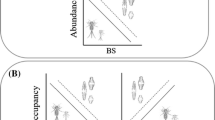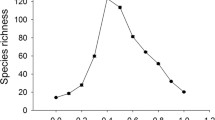Abstract
Levins’s asymmetrical α index quantifies between species overlap over resources more realistically than similar-purpose single-value indices. The associated community-wide \(\bar \alpha\) index expresses the degree of “species packing”. Both indices were formulated upon competing animal (i.e., mobile) organisms and are independent of population densities. However, overlap over resources for nonmobile organisms such as plants may have an impact even below carrying capacity. The proposed \(\hat \alpha\) index, based on Levins’s α index, quantifies spatial overlap for plants integrating information on species spatial distribution and crowding conditions. The \(\hat \alpha\) index is specifically designed for plant distribution data collected in discrete plots with density expressed as percent coverage (%cover) of substratum. We also propose a community-wide \({\hat \alpha_{\text{c}}}\) index, conceptually analogous to \(\bar \alpha\), but furnished with a measure of dispersion (se \({\hat \alpha_{\text{c}}}\)). Species importance within the community is inferred from comparisons of pairwise \(\hat \alpha\)’s with \({\hat \alpha_{\text{c}}}\). The \(\hat \alpha\) and \({\hat \alpha_{\text{c}}}\) indices correlate closely and exponentially with plant density, and correct apparent over- and underestimations of interaction intensity at low and very high crowding by Levins’s α and \(\bar \alpha\), respectively. Index application to aquatic plant communities gave results consistent with within-community and general ecological patterns, suggesting a high potential of the proposed \(\hat \alpha\) and \({\hat \alpha_{\text{c}}}\) indices in basic and applied macrophyte ecological studies and management.





Similar content being viewed by others
Notes
A comparison between the association strength (r 2) of the two regressions in Fig. 4, and not the very small P values (a feature of sample-size-dependent regression analysis), is the real object of this analysis.
References
Abernethy, V. J., M. R. Sabbatini & K. J. Murphy, 1996. Response of Elodea canadensis Michx. and Myriophyllum spicatum L. to shade, cutting and competition in experimental culture. Hydrobiologia 340: 219–224.
Andrews, H. P., R. D. Snee & M. H. Sarner, 1980. Graphical display of means. American Statistician 34(4): 195–199.
Bowmer, K. H., D. S. Mitchell & D. L. Short, 1984. Biology of Elodea canadensis Michx. and its management in Australian irrigation systems. Aquatic Botany 18: 231–238.
Bruno, J. F. & C. W. Kennedy, 2000. Patch-size dependent habitat modification and facilitation on New England cobble beaches by Spartina alterniflora. Oecologia 122: 98–108.
Chambers, P. A. & E. E. Prepas, 1990. Competition and coexistence in submerged aquatic plant communities: the effects of species interactions versus abiotic factors. Freshwater Biology 23: 541–550.
Collins, C. D., R. B. Sheldon & C. W. Boylen, 1987. Littoral zone macrophyte community structure: distribution and association of species along physical gradients in Lake George, New York, USA. Aquatic Botany 29: 177–194.
Connell, J. H., 1980. Diversity and the coevolution of competitors, or the ghost of competition past. Oikos 35: 131–138.
Connell, J. H., 1983. On the prevalence and relative importance of interspecific competition: evidence from field experiments. The American Naturalist 122: 661–696.
Craine, J. M., J. Fargione & S. Sugita, 2005. Supply pre-emption, not concentration reduction, is the mechanism of competition for nutrients. New Phytologist 166: 933–940.
Edwards, D., 1996. Comment: the first data analysis should be journalistic. Ecological Applications 6: 1090–1094.
Egerston, C. J., J. A. Kopaska & J. A. Downing, 2004. A century of change in macrophyte abundance and composition in response to agricultural eutrophication. Hydrobiologia 524: 145–156.
ENSR, 2000. Survey of the Submerged Aquatic Vegetation and Vegetation Management Recommendations for Fort Meadow Reservoir, Marlborough, MA. Final Report to the Conservation Commission of the City of Marlborough, MA.
French, T. D. & P. A. Chambers, 1996. Habitat partitioning in riverine macrophyte communities. Freshwater Biology 36: 509–520.
Gause, G. F., 1934. The Struggle for Existence. Williams & Wilkins, Baltimore, MD.
Goldberg, D. E. & S. M. Scheiner, 2001. ANOVA and ANCOVA: field competition experiments. In Scheiner, S. M. & J. Gurevitch (eds.), Design and Analysis of Ecological Experiments, 2nd ed. Oxford University Press, New York, NY: 77–98.
Hurlbert, S. J., 1984. Pseudoreplication and the design of ecological field experiments. Ecological Monographs 54: 187–211.
Hutchinson, G. E., 1961. The paradox of the plankton. The American Naturalist 95: 137–145.
IEP, 1987. Diagnostic Feasibility Study, Fort Meadow Reservoir, Marlborough/Hudson, Massachusetts. Final Report to the City of Marlborough and the Town of Hudson, MA.
Kłosowski, S., E. Jabłońska & M. Szańkowski, 2011. Aquatic vegetation as an indicator of littoral habitats and various stages of lake aging in north-eastern Poland. Annales de Limnologie – International Journal of Limnology 47: 281–295.
Knapton, R. W. & S. A. Petrie, 1999. Changes in distribution and abundance of submerged macrophytes in the Inner Bay at Long Point, Lake Erie: implications for foraging waterfowl. Journal of Great Lakes Research 25: 783–798.
Kolada, A., S. Hellsten, A. Kanninen, Ma. Søndergaard, B. Dudley, P. Nõges, I. Ott, F. Ecke, M. Mjelde, V. Bertrin, T. Davidson & H. Duel, 2011. Overview and comparison of macrophyte survey methods used in European countries and a proposal of harmonized common sampling protocol to be used for WISER uncertainty exercise including a relevant common species list. Deliverable D3.2-1, part of the final WISER report to the European Commission, 7th WFD Programme, Brussels, B.
Levins, R., 1968. Evolution in Changing Environments – Some Theoretical Explorations. Princeton University Press, Princeton, NJ.
Lombardo, P. & G. D. Cooke, 2004. Resource use and partitioning by two co-occurring gastropod species. Archiv für Hydrobiologie 159: 229–251.
MA DEP, 2003. Massachusetts Year 2002 Integrated List of Waters Part 2 – Final Listing of Individual Categories of Waters CN 125.2. Massachusetts Department of Environmental Protection, Division of Watershed Management, Worcester, MA.
May, R. M., 1972. Will a large complex system be stable? Nature 238: 413–414.
May, R. M., 1975. Some notes on estimating the competition matrix, α. Ecology 56: 737–741.
Mikulyuk, A., J. Hauxwell, P. Rasmussen, S. Knight, K. I. Wagner, M. E. Nault & D. Ridgely, 2010. Testing a methodology for assessing plant communities in temperate inland lakes. Lake and Reservoir Management 26: 54–62.
Mjelde, M., P. Lombardo, D. Berge & S. W. Johansen, 2012. Mass invasion of non-native Elodea canadensis Michx. in a large, clear-water, species-rich Norwegian lake – impact on macrophyte biodiversity. Annales de Limnologie – International Journal of Limnology 48: 225–240.
Mueller, L. D. & L. Altenberg, 1985. Statistical inference on measures of niche overlap. Ecology 66: 1204–1210.
Paul, S. R., 1988. Estimation of and testing significance for a common correlation coefficient. Communications in Statistics – Theory and Methods 17: 39–53.
Petren, K. & T. J. Case, 1996. An experimental demonstration of exploitation competition in an ongoing invasion. Ecology 77: 118–132.
Pianka, E. R., 1973. The structure of lizard communities. Annual Review of Ecology and Systematics 4: 53–74.
Prairie, Y. T., 1996. Evaluating the predictive power of regression models. Canadian Journal of Fisheries and Aquatic Sciences 53: 490–492.
Reader, R. J., 1992. Herbivory as a confounding factor in an experiment measuring competition among plants. Ecology 73: 373–376.
Rørslett, B., 1983. Tyrifjord og Steinsfjord – Undersøkelse av Vannvegetasjon 1977–1982. NIVA Report lnr. 1510. NIVA, Oslo, N.
Rørslett, B., N. W. Green & K. Kvalvågnes, 1978. Stereophotography as a tool in aquatic biology. Aquatic Botany 4: 61–68.
Scheffer, M., S. Rinaldi, J. Huisman & F. J. Weissing, 2003. Why plankton communities have no equilibrium: solutions to the paradox. Hydrobiologia 491: 9–18.
Schmitt, R. J., 1996. Exploitation competition in mobile grazers: trade-offs in use of a limited resource. Ecology 77: 408–425.
Schoener, T. W., 1970. Non-synchronous spatial overlap of lizards in patchy habitats. Ecology 51: 408–418.
Silander, J. A. & J. Antonovics, 1982. Analysis of interspecific interactions in a coastal plant community – a perturbation approach. Nature 298: 557–560.
Slobodchikoff, C. N. & W. C. Schulz, 1980. Measures of niche overlap. Ecology 61: 1051–1055.
Smart, M.M., S.A. Nichols, J.H. Peck & R.G. Wetzel, 2005. Macrophytes. In: Eaton, A.D., L.S. Clesceri, E.W. Rice & A.E. Greenberg (eds), Standard Methods for the Examination of Water and Wastewater, 21st ed. APHA, Washington, DC. Section 10400.
Thomson, J. D., 1980. Implications of different sorts of evidence for competition. The American Naturalist 116: 719–726.
Underwood, A. J., 1997. Experiments in Ecology – Their Logical Design and Interpretation Using Analysis of Variance. Cambridge University Press, Cambridge, UK.
Volterra, V., 1926. Variations and fluctuations of the number of individuals in animal species living together. In Chapman, R. N. (ed.), Animal Ecology. McGraw-Hill, New York, NY: 409–448.
Zar, J. H., 2009. Biostatistical Analysis, 5th ed. Prentice Hall/Pearson, Upper Saddle River, NJ.
Acknowledgments
Constructive criticism by Dr. G. Dennis Cooke and Prof. David W. Waller (Kent State University); Dr. Tom Andersen (University of Oslo); Prof. Bruno Cicolani, Dr. Francesco Paolo Miccoli and Dr. Antonio Di Sabatino (University of L’Aquila); Dr. Gaetano De Luca (Italian Institute of Vulcanology and Seismology/INFN); Dr. John Silander (University of Connecticut), and two anonymous reviewers greatly improved the paper. We also thank Ms. Priscilla Ryder, Conservation Officer of the City of Marlborough, for permission to use the Fort Meadow Reservoir data. Our thanks go to the NIVA and ENSR employees who contributed to collect field data in Steinsfjord and Fort Meadow Reservoir, respectively. The index was developed as a spinoff activity of project # 154270/S30 (monitoring of E. canadensis in Steinsfjord), awarded by the Norwegian Research Council to NIVA. Our thanks also go to Mr. Dag Berge, the Steinsfjord project manager, for his continued support on pursuing the idea that led to this paper.
Author information
Authors and Affiliations
Corresponding author
Additional information
Guest editors: M. T. Ferreira, M. O’Hare, K. Szoszkiewicz & S. Hellsten / Plants in Hydrosystems: From Functional Ecology to Weed Research
Rights and permissions
About this article
Cite this article
Lombardo, P., Mjelde, M. Quantifying interspecific spatial overlap in aquatic macrophyte communities. Hydrobiologia 737, 25–43 (2014). https://doi.org/10.1007/s10750-013-1716-1
Received:
Accepted:
Published:
Issue Date:
DOI: https://doi.org/10.1007/s10750-013-1716-1




